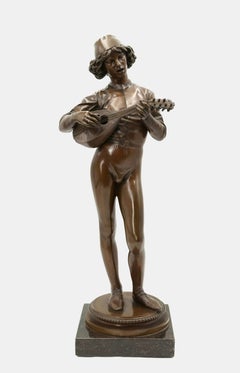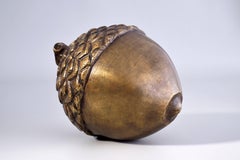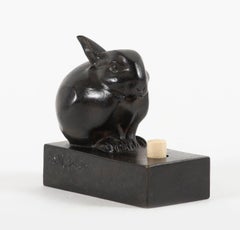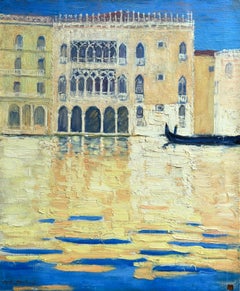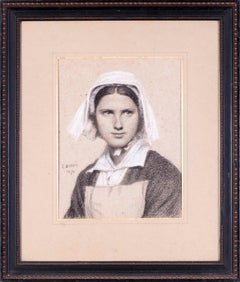Paul Dubois Art
to
1
Overall Width
to
Overall Height
to
1
1
1
1
1
1
1
1
6
10,042
2,764
1,381
1,375
1
Artist: Paul Dubois
Florentine singer / - The Renaissance of the Renaissance -
By Paul Dubois
Located in Berlin, DE
Paul Dubois (1829 Nogent-sur-Seine - 1905 Paris), Florentine singer, 1865. Light brown patinated bronze with cast round plinth mounted on a square marble base (3.5 cm high). Total height 53 cm. Bronze dimensions: 49.5 cm (height) x 20 cm (length) x 10 cm (width), weight 5.6 kg. Inscribed on the plinth "P.[aul] DUBOIS", dated "1865", with the foundry's mark "F. BARBEDIENNE FONDEUR" and the signet "REDUCTION MECANIQUE A. COLLAS".
- Patina very occasionally darkened, lute with loss of one tuning peg, otherwise in excellent condition.
- The renaissance of the Renaissance -
The bronze is a precisely executed and masterfully cast contemporary reduction of Paul Dubois 155 cm tall masterpiece "Florentine Singer", which is exhibited in the Musée d'Orsay and for which the artist was awarded the Medal of Honor at the Paris Salon in 1865. The work acted as a beacon, and was followed by a plethora of depictions of juveniles.
Inspired by Donatello and Luca della Robbia, but also by painters such as Piero della Francesca, Benozzo Gozzoli, and Pinturicchio, the "Florentine Singer" is not an epigonal work that pays homage to a vanished era, but a successful attempt to draw vitality from the art of the past and thus give it new life.
The effect of vitality is the core of Italian Renaissance art theory. In order to fulfill itself as art, art had to appear like nature. This naturalism also characterizes the "Florentine Singer". The young man appears to have been taken from life, which is reinforced by the momentary nature of his action. He has just struck a now fading chord. In addition, the natural appearance is enhanced by the detailed shaping of the figurative details, such as the laces with the slightly curved leather of the shoes, the belt buckle, or the ornamentation on the body of the lute. Even the fingernails are clearly defined. Unlike the Renaissance, however, the effect of liveliness here is not based on the "discovery" of nature and the human body, but primarily on the rediscovery of the art of the Quattrocento. The liveliness of the artwork is therefore at the same time a revitalization of this art, so that we can speak of a Renaissance of the Renaissance, just as the Pre-Raphaelites in England at the same time transferred the Quattrocento to contemporary art.
Dubois takes on the most difficult of all subjects, the depiction of singing through silent sculpture. He was preceded in this by Luca della Robbia and Donatello with their pulpits of singers created in the 1430s in the Museo dell'Opera del Duomo in Florence. Compared to these works, the physiognomy of Dubois singer is far less animated, yet he also depicts singing in a convincing manner. He uses the whole body. He takes the ancient contrapposto, which was essential to Renaissance sculpture, and transforms the standing leg-playing posture into a late medieval S-swing, giving the body an elegant beauty and at the same time setting it in melodic motion. In the equally elegant finger position, the music is expressed in a much more literal way with the beating of the lute. Finally, the musicality of the sculpture culminates in the face with the mouth open to sing.
Through the act of singing, which is a great challenge to the artistic will to depict perfect beauty, the gracefulness of the classical face is not diminished, but enhanced. Starting from the face with the singing mouth and the gaze absorbed by the sounds, the inner vitality spreads, giving the bronze sculpture an intense aura, enhanced by the music. Dubois transfers the beauty of the Renaissance to the musical, sublimating the visible sculpture to the invisible of music.
He took up the challenge of transcending the Renaissance with the Renaissance, thus responding to the Querelle des Anciens et des Modernes, which arose at the end of the 17th century around the French Academy and remained virulent into the 19th century, in which antiquity was regarded either as an unattainable ideal or as a standard to be surpassed. With his work, Dubois proved that the Renaissance, which had championed the art of the ancients, could lead to a new renaissance of art.
About the artist
Paul Dubois' great-uncle was the famous French Baroque sculptor Jean-Baptiste Pigalle, in whose footsteps the talented great-nephew followed. When he debuted at the Paris Salon in 1858, he signed his work "Dubois-Pigalle". At his father's request, however, he first studied law before devoting himself to sculpture under the tutelage of François Christophe Armand Toussaint in 1856 and entering the École des Beaux-Arts in 1858. From 1859 to 1863, he lived in Rome and traveled to Naples and Florence. Inspired by Florentine art of the quattrocento, Dubois initiated a school-forming neo-Florentine style that combined the elegantly simple forms of youthful grace with a precise wealth of detail.Two purchases by the French state (“envois de Rome”) were made during his stay in Rome, which brought him recognition in Paris. After his return there, he quickly became an internationally sought-after artist.
Dubois was also active as a creator of monuments. His most famous work is the equestrian statue of Joan of Arc (1896) on the forecourt of Reims Cathedral. He was also a sought-after portraitist who produced around 50 busts and - Dubois was also a passionate painter - around 100 portraits in oil.
From 1873 to 1878 he was curator of the Museum du Luxembourg, in 1876 he became a member of the Institut de France and from 1878 to 1905 he was director of the École des Beaux-Arts.
In 1865, Dubois was awarded the Paris Salon Medal of Honor for his “Florentine Singer”. In 1867 he became Chevalier, in 1874 Officier, in 1886 Commandeur of the Légion d'honneur, which awarded Dubois the Grande Croix in 1896.
Selected Bibliography
Stole, Elmar: Paul Dubois. In: Saur. Allgemeines Künstlerlexikon, vol. 30, Munich - Leipzig 2001, pp. 677-678.
GERMAN VERSION
Paul Dubois (1829 Nogent-sur-Seine - 1905 Paris), Florentinischer Sänger, 1865. Hellbraun patinierte Bronze mit gegossener runder Plinthe auf quadratischem Marmorsockel montiert (3,5 cm Höhe). Gesamthöhe 53 cm. Maße der Bronze: 49,5 cm (Höhe) x 20 cm (Länge) x 10 cm (Breite), Gewicht 5,6 kg. Auf der Plinthe mit „P.[aul] DUBOIS“ bezeichnet, auf „1865“ datiert, mit dem Gießereistempel „F. BARBEDIENNE FONDEUR“ und dem Signet „REDUCTION MECANIQUE A. COLLAS“ versehen.
- Patina sehr vereinzelt nachgedunkelt, Laute mit Verlust eines Stimmwirbels, ansonsten ausgezeichnet erhalten.
- Die Renaissance...
Category
1860s Realist Paul Dubois Art
Materials
Bronze
Related Items
Bellota 7
By María José de la Macorra
Located in Mexico City, CDMX
María José de la Macorra (México, D.F., 1964) realizó sus estudios en la Escuela de Cerámica y Porcelana de Toluca, Mokichi Okada Association,...
Category
2010s Naturalistic Paul Dubois Art
Materials
Bronze
Lapin bijou sonnette, Sandoz, Ring, Rabbit, Bronze, animal, sculpture, 1920's
By Edouard-Marcel Sandoz
Located in Geneva, CH
Lapin bijou, sonnette, circa 1920-1930
Fondry Susse, Ed. 1748 pcs
Bronze with a brown patina
H. 6.5 cm
Signed on the side of the base : Ed.m.Sandoz
Sandoz : Sculpteur Figuriste et An...
Category
1920s Modern Paul Dubois Art
Materials
Bronze
$9,382
H 2.56 in W 3.15 in D 1.19 in
1920s Italian Signed Bronze Sculpture
By Elisabetta Mayo D’Aloisio
Located in Roma, IT
Bronze on a marble base It bears Mayo's signature.
Trademark Fondart - Lagana Napoli.
“Of the first sculpture, a group of highly vigorous original artistry, all that remains is Ada...
Category
Early 20th Century Art Deco Paul Dubois Art
Materials
Marble, Bronze
$4,780
H 10.24 in W 10.63 in D 11.42 in
Rare Milk Glass Carved Sculpture Panel Cowboy Indian WPA Artist Americana
By Abraham Harriton
Located in Surfside, FL
This is a carved glass panel. I belive this is milk glass. it is a classic Americana scene of a cowboy or frontier trapper and an Indian or Native American with a feathered headdress...
Category
Mid-20th Century Realist Paul Dubois Art
Materials
Glass
Plains Drummer medallion bronze by Allan Houser Apache
By Allan Houser
Located in Santa Fe, NM
Plains Drummer medallion bronze by Allan Houser Apache
Bronze medallion by Allan Houser
Plains Indian drummer
Category
1980s Contemporary Paul Dubois Art
Materials
Bronze
Lapin assis, tête tournée, Sandoz, 1910's, bronze, animal, rabbits, rare proof
By Edouard-Marcel Sandoz
Located in Geneva, CH
Lapin assis, tête tournée, circa 1919-1921
Fondry Susse, Ed. 3/5 pcs
circa 1919-1921
Rare bronze proof with a brown patina
8.5 x 5.5 x 6.5 cm
Certificate of authenticity issued by th...
Category
1910s Modern Paul Dubois Art
Materials
Bronze
$20,199
H 3.35 in W 2.17 in D 2.56 in
Birdman – Contemporary Hybrid Human-Bird Sculpture by Zura
Located in Brooklyn, NY
More than a creature, Birdman embodies transformation and duality. Is it a guardian, a trickster, or an internal self-reflection? Its bird-like head and humanoid stance invite viewer...
Category
21st Century and Contemporary Contemporary Paul Dubois Art
Materials
Bronze
Kuznetsov porcelain - Butter dish duck, porcelain h 13 cm; L 19 cm; W 10 cm
Located in Riga, LV
Kuznetsov porcelain - Butter dish duck, porcelain h 13 cm; L 19 cm; W 10 cm
Kuznetsov Porcelain Factory in Riga was founded in 1841 as a factory ...
Category
Early 20th Century Realist Paul Dubois Art
Materials
Porcelain
$764 Sale Price
20% Off
H 5.12 in W 7.49 in D 3.94 in
Chien à la sauterelle, Sandoz, Dog, Sculpture, Bronze, Animal, 1910's
By Edouard-Marcel Sandoz
Located in Geneva, CH
Chien à la sauterelle, Sandoz, Dog, Sculpture, Bronze, Animal, 1910's
Chien à la sauterelle
Susse Fondeur
circa 1918-1930
Bronze with brown patina and shade of green
13 x 13 x 9 cm
Signed and seal of the foundry on the base : Sandoz, Susse Fondeur
Catalogue raisonné de l'oeuvre sculpté de Edouard Marcel Sandoz, sculpteur figuriste et animalier 1881-1971, by Félix Marcilhac, Les Editions de l'amateur, 1993...
Category
1910s Modern Paul Dubois Art
Materials
Bronze
$32,270
H 5.12 in W 5.12 in D 3.55 in
Lapin, by Sandoz, rabbit, animal, sculpture, bronze, 1910's, swiss artist, cast
By Edouard-Marcel Sandoz
Located in Geneva, CH
Lapin, modèle 5, circa 1919-1921
Fondeur Susse
Bronze with brown patina
6.5 x 4.9 x 6.5 cm
Inscribed and foundry stamp : Ed.m.Sandoz, Susse Frères Editeurs
Certificate of authentici...
Category
1910s Modern Paul Dubois Art
Materials
Bronze
$16,135
H 2.56 in W 1.93 in D 2.56 in
Beat of the Drum Paul Moore bronze Native American man with Drum, headdress
By Paul Moore
Located in Santa Fe, NM
Beat of the Drum Paul Moore bronze Native American man with Drum, headdress
Paul Moore was born in Oklahoma City a member of the (Creek) Muscogee N...
Category
1990s Contemporary Paul Dubois Art
Materials
Bronze
$22,000
H 64 in W 25 in D 21 in
Lapin, by Sandoz, Rabbit, animal, sculpture, bronze, 1910's, brown patina, cast
By Edouard-Marcel Sandoz
Located in Geneva, CH
Lapin couché, circa 1919-1925
Fondry Susse, Ed. 10 pcs
Bronze with a brown patina
H. 6 cm
Sandoz : Sculpteur Figuriste et Animalier 1881-1971, Catalogue Raisonné de l'Oeuvre Sculpté...
Category
1910s Modern Paul Dubois Art
Materials
Bronze
$16,135
H 2.37 in W 2.37 in D 1.58 in
Previously Available Items
Venice - Orientalist Oil, Gondola on the Canal Landscape by Paul Elie Dubois
By Paul Dubois
Located in Marlow, Buckinghamshire
A wonderful oil on canvas by French Orientalist painter Paul Elie Dubois depicting a gondola sailing along the canal in Venice, the buildings bordering the canals reflecting in the water. Signed lower left and signed & titled verso.
Dimensions:
Framed: 37"x32"
Unframed: 26"x21"
Provenance:
Private French collection
Exhibition number on canvas lower right corner - likely from the Societe Des Artistes Francais 1922
Born 29 October 1886, in Colombier-Chatelot; died 14...
Category
1920s Post-Impressionist Paul Dubois Art
Materials
Canvas, Oil
19th Century drawing of a Breton Girl by Paul Dubois
By Paul Dubois
Located in Petworth, West Sussex
Paul Dubois (French 1829 – 1905)
‘La Jeune Bretonne’, 1871/8
Black crayon and chalk on paper
Signed and dated ‘P. Dubois 1871/8’
11.3/4 x 9 in. (30 x 23 cm.)
Category
19th Century Realist Paul Dubois Art
Materials
Chalk, Crayon
Nymphe portee par des amours
By Paul Dubois
Located in Petworth, West Sussex
Paul Dubois (French, 1829 – 1905)
Nymphe portee par des amours
Oil on panel
26.1/2 x 40in. (67.3 x 101.7cm.)
Provenance: From the estate of the artist and then by descent.
It is in...
Category
Late 19th Century Paul Dubois Art
Materials
Oil, Panel
Paul Dubois art for sale on 1stDibs.
Find a wide variety of authentic Paul Dubois art available for sale on 1stDibs.
